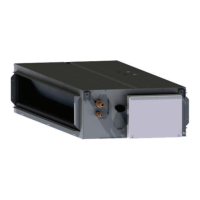Special attention regarding refrigerant gas leakage
Pay attention to the critical gas concentration to avoid accidental refrigerant gas leakage before installing air conditioning systems.
Totally charged refrigerant quantity in system (kg)
≤ Critical concentration (kg/m
3
)
Room space for each indoor unit (m
3
)
0.3 kg/m
3
*
* In case of KHK S 0010, this value should be decided according to each country’s regulation such as ISO5149 and EN378.
In the case that the calculated critical concentration is higher than 0.3kg/m
3
, take the following actions.
1 Provide a gas leakage detector and exhaust fan(s) controlled by its gas leakage detector.
2 Provide each effective opening at the wall or door for ventilation to next door so that the critical gas concentration can be main-
tained lower than the above value. (Provide an opening more than 0.15% of oor surface at the lower part of a door.)
CAUTION
1 Maximum permissible concentration of HFC GAS R410A. The refrigerant R410A is an incombustible and non-toxic gas.
However, if leakage occurs and gas lls a room, it may cause suffocation. The maximum permissible concentration of HFC gas,
R410A in air is 0.3 kg/m
3
, according to the refrigeration and air conditioning facility standard (KHK S 0010) by the KHK (High Pressure
Gas Protection Association) Japan. Therefore, some effective measure must be taken to lower the R410A concentration in air below
0.3kg/m
3
, in case of leakage. As for R410A, this consideration is applied similarly.
2 Calculation of refrigerant concentration:
1 Calculate the total quantity of refrigerant R (kg) charged in the system connecting all the indoor units of objective rooms.
2 Calculate the room space where this unit is to be installed V (m
3
) of each objective room.
3 Calculate the refrigerant concentration C (kg/m
3
) of the room according to the following equation.
R: Total Quantity of Charged Refrigerant (kg)
=
C: Refrigerant concentration ≤ 0.3 (kg/m
3
)*
V: Room Space Where This Unit Is to Be Installed (m
3
)
If local codes or regulations are specied, follow them. Example:
Japanese Standard KHK S 0010 C=0.3 (kg/m
3
)
9.5.1 Precautions in the event of refrigerant leaks
DANGER
Fitters and the designers of the installations must strictly observe local and national legislation, and local codes regarding
safety requirements in the event of refrigerant leaks.
Maximum permitted concentration of hydrouorcarbon (HFC)
The R410A refrigerant gas, used in the equipment, is reproof and not toxic.
DANGER
In the event of a leak, the gas will spread around the room, displacing the air, and could therefore result in asphyxia.
The maximum permitted concentration of HFC R410A gas in the air is 0.44 kg/m
3
, in accordance with standard EN378-1. Therefore, ef-
cient measures should be adopted to ensure the concentration of R410A gas in the air is kept below 0.44 kg/m
3
in the event of a leak.
Calculation of the refrigerant concentration
1 Calculate the total quantity of refrigerant R (kg) charged in the system; to do so, connect all the indoor units of the rooms in which
you wish to have air conditioning.
2 Calculate the volume V (m
3
) of each room.
3 Calculate the refrigerant concentration C (kg/m
3
) of the room according to the following formula:
R / V = C
R: Total quantity of refrigerant charged (kg).
V: volume of the room (m
3
).
C: concentration of refrigerant (= 0.44 kg/m
3
for R410A gas).
56
PMML0294A rev.2 - 07/2014
Additional refrigerant charge
PMML0294A_rev.2_02-2014.indb 56 14/07/2014 12:28:32

